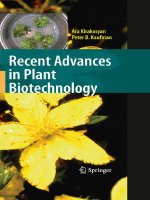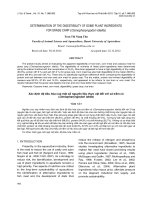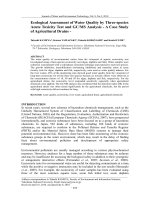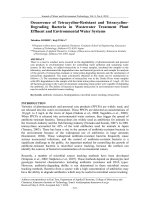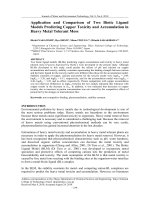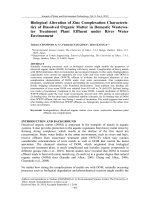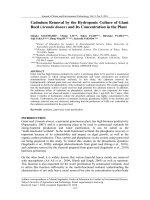Plant toxicity symptoms
Bạn đang xem bản rút gọn của tài liệu. Xem và tải ngay bản đầy đủ của tài liệu tại đây (7.74 MB, 17 trang )
Plants
toxicity
symptoms
Students : Vu Thi Hong Van
1, Basic background
▪ 1.1. What is nutrient toxicity in plants ?
presence in the soil of a plant nutrient in such high concentratio
t it is harmful to the plant.
Figure 1. Relationship between plant
growth and health and amount of nutrient
Figure 2. Iron toxicity on ric
1.2 How to differentiate nutrient deficiency and
toxicity ?
Toxicities
▪ Slow to mature
▪ Tall plants with weak stems
▪ Chlorosis, or paling, yellow
discoloration on leaves
▪ Lesions on the roots and
stems
▪ Leaves falling prematurely
▪ Reduced root growth
Deficiency
▪ Chlorosis
▪ Generalized symptoms as opposed
to localized
▪ Stunted growth
▪ Leaves turning purple or reddish
▪ Interveinal chlorosis, or chlorosis
between leaf veins while veins
remain green
▪ Necrosis, or dying plant tissue
2, Types of plant toxicities : Fertilizer
burn and nutrient imbalance
2.1.1. Fertilizer burn is defined as leaf
scorch resulting from over-fertilization.
Figure 3. Yellow grass resulted
from fertilizer burn
Figure 4. Sunburnt guy
NITROGEN
Click icon to add picture
Deficiency: Plants will exhibit lack of
vigor as older leaves become yellow
(chlorotic) from lack of chlorophyll.
Chlorosis will eventually spread
throughout the plant. Stems, petioles
and lower leaf surfaces may turn
purple.
Toxicity: Leaves are often dark green
and in the early stages abundant with
foliage. If excess is severe, leaves will
dry and begin to fall off. Root system
will remain under developed or
deteriorate after time. Fruit and
flower set will be inhibited or
deformed
PHOTPHORUS
Click icon to add picture
Deficiency: Plants are
stunted and older leaves
often dark dull green in color.
Stems and leafstalk may turn
purple. Plant maturity is
often delayed.
Toxicity: This condition is
rare and usually buffered by
pH limitations. Excess
phosphorus can interfere with
the availability of copper and
zinc.
POTASSIUM
Deficiency: Older leaves are
initially chlorotic but soon
develop dark necrotic lesions
(dead tissue). First apparent on
the tips and margins of the
leaves. Stem and branches may
become weak and easily broken.
Toxicity: Usually not absorbed
excessively by plants. Excess
potassium can aggravate the
uptake of magnesium,
manganese, zinc and iron.
2.1.2.Why fertilizer burn can harm
plants ?
Ans : Chemical fertilizers are made up of mineral
salts. When you over fertilize, the salts build up in the soil
and cause a drying effect, which can result in the grass
turning yellow or brown.
2.1.3.How to avoid
fertilizer burn ?
1, Following the instruction on the package
2, Using slow-release fertilizer
3, Fertilizing your plants with compost eliminates the
risk of fertilizer burn.
2.1.4.How to treat fertilizer burn ?
1, Remove any visible
fertilizer.
2, Leach the soil with
water.
3, Flood the root system.
4, Allow the water to drain
away.
2.2 Nutrient imbalances in plants
▪ 2.2.1, Definition : Nutrient imbalances in plants happen when
plants have problem with absorbing nutrients or something is
affecting the availability of the nutrient in soil.
2.2.2, Why nutrient imbalances are a
problem ?
Because these phenomenon bring negative effects to the
yield and the plant growth.
MAGNESIUM
Deficiency: Interveinal
chlorosis on younger or older
leaves followed by necrotic
lesions or leaf shedding.
Restricted growth and failure to
mature normally can also result.
Toxicity: Chlorosis, or blotchy
leaf tissue due to insufficient
chlorophyll synthesis. Growth
rate will slow and vigor will
decline.
CALCIUM
Deficiency: Young leaves are
affected first and become small
and distorted or chlorotic with
irregular margins, spotting or
necrotic areas. Bud
development is inhibited and
roots may be underdeveloped or
die back. Fruit may be stunted
or deformed.
Toxicity: Difficult to distinguish
visually. May precipitate with
sulfur in solution and cause
clouding or residue in tank.
IRON Fe
Deficiency: Pronounced
interveinal chlorosis
similar to that cased by
magnesium deficiency but
on the younger leaves.
Toxicity: Excess
accumulation is rare but
could cause bronzing or
tiny brown spots on leaf
surface.
MAGANESE
Deficiency: Interveinal
chlorosis on younger or older
leaves followed by necrotic
lesions or leaf shedding.
Restricted growth and failure to
mature normally can also result.
Toxicity: Chlorosis, or blotchy
leaf tissue due to insufficient
chlorophyll synthesis. Growth
rate will slow and vigor will
decline.
ZINC Zn
Deficiency: Chlorosis may
accompany reduction of leaf
size and a shortening between
internodes. Leaf margins are
often distorted or wrinkled.
Toxicity: Zinc in excess is
extremely toxic and will cause
rapid death. Excess zinc
interferes with iron causing
chlorosis from iron deficiency.
2.2.4. How to prevent nutrient
imbalances ?
Two Content Layout with Table
▪ First bullet point here
Class
▪ Second bullet point here
▪ Third bullet point here
Group A
Group B
Class 1
82
95
Class 2
76
88
Class 3
84
90
